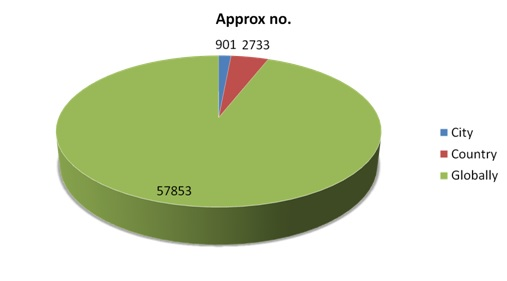Theme: Advanced Research and Emerging Issues in the Field of Virology
Euro Virology 2018
Conferenceseries llc LTD organizes about over 1000 Global Events which are inclusive of the 400+ Conferences, 300+ Workshops and about 300+ Symposiums every year throughout the world- across USA, Europe & Asia-Pacific with the support of over 1000 scientific societies, while having already published about more than 500 Open access journals containing over 50,000 eminent and reputed scientists as editorial board members.
On behalf of the Conferenceseries llc LTD Euro Viorology 2018 invites all the interested speakers, delegates, students and young achievers to attend 10th International Virology Summit to be held during July 02-04, 2018 at Vienna, Austria.
After the Successful completion of Euro Virology 2017 at London, UK during March 13-14, 2017, we are glad to announce the succeeding "10th International Virology Summit" to be held during July 02-04, 2018 at Vienna, Austria. Euro Virology 2018 invites connoisseurs from all pre-eminent universities, research institutions, microbiologists, virologists and diagnostic companies to share their research papers on all aspects of this rapidly augmenting field and emblazoning the recent advancements and technologies being currently used and the ones being developed on futuristic technologies for further research on viruses.
Track 1: General Virology and Immunization against viral diseases
Viruses are smallest known infectious agents they can infect animals, plants, insects and even bacteria. A wide range of viruses are characterized according to their size and their resistance to chemical or physicals agents (alcohol,ether, etc ) and pathogenic affects. In modern period they focused on two things 1.Viruses are replicated in but they dependent on host cell machinery 2.reombinant DNA is revolution began,both bacterial and animal viruses played a critical role in this revolution. Due to this reasons they mainly focused on use of virus in cellular and molecular biology as they probe to many diverse questions in biology.Viruses exhibit strong immunological responses with both cellular and humoral immunity.Virus replication takes place in stages are adsorption , penetration, uncoating ,transcription, translation ,synthesis of nucieic acids ,assembly and the release of new virions. Many of the Antivirals were developed to treat viral infections by affecting of the viral replication stages.
Recommended VirologyConferences | Microbiology Conferences | Clinical Virology Conferences | Conference Series
Track 2: Diagnostic and clinical Virology
Earlier, it is outside the main stream of the clinical laboratory medicine. In recent years, it is presently integrated into routine medical practice. It is mainly due to HIV and AIDS epidemic and the success of hematopoietic stem cell and solid organ transplantation has greatly increased the pool of patients at risk for serious opportunistic viral infections. Vector-borne diseases are the infections transmitted by the bite of infected arthropod species like mosquitoes, ticks, sandflies, blackflies, etc. A blood-borne disease is spread through contamination by blood and other body fluids. RNA silencing controls gene expression to regulate the development, genome stability and also anxiety incited reactions. In plants, RNA silencing is recognized as a major immune system targeted against plant viruses.
Recommended VirologyConferences | Microbiology Conferences | Clinical Virology Conferences | Conference Series
Track 3: Epidemiology of virus
Viral epidemiology is concerned with study of incidence and spread of viruses in population over time. Host, virus and environmental factors are monitored to determine the dynamics of viral infections, the ultimate goal of which is to devise intervention strategies. Inthe epidemiological sense, 'pathogenicity' is the proportion of total infections that produce overt disease, which varies from virus to virus and may be affected by host factors. This review emphasis on the epidemiology of newly emerged virus and diseases in man and animals,such as acquired immunodeficiency syndrome, bovine spongiform encephalopathy, canine haemorraghic disease and respiratory syndrome in horses.
Recommended VirologyConferences | Microbiology Conferences | Clinical Virology Conferences | Conference Series
Track 4: Insect Virus and Fungal Virology
Currently, molecular studies on replication, assembly, host interactions of insect viruses have contributed enormously to molecular ,cellular ,organismal biology. The ease with which many insect viruses are propagated in cell cultures or live animals, the high yields virus particles or virus encoded macromolecules, and the simplicity with which many insect viruses can be genetically manipulated represent just a few experimental advantages provided by these pathogens.It deals with viruses that infect fungi are known as Mycoviruses. Mycoviruses have double-stranded RNA genomes and isometric particles, but about 30% of them have positive sense and single-stranded RNA genomes, to be a true Mycoviruses, they must have an ability to be transmitted ( in other words be able to infect other healthy fungi).
Recommended VirologyConferences | Microbiology Conferences | Clinical Virology Conferences | Conference Series
Track 5: HIV , AIDS and Emerging Issues
The human immunodeficiency virus is a lentivirus that causes HIV infection and AIDS.HIV diagnosis is done by testing your blood or saliva for antibodies to the virus. HIV/AIDS clinical trials are research studies done to have a better approach, distinguish, or treat HIV/AIDS. Clinical trials are the predominant way to determine if new medical approaches to HIV/AIDS are safe and effective in people
Recommended VirologyConferences | Microbiology Conferences | Clinical Virology Conferences | Conference Series
Track 6: Plant and Agricultural Virology
The epidemiology of plant virus diseases concerns the cyclical development of virus diseases within plant populations in time and space. Tobacco mosaic virus (TMV) is a positive-sense single stranded RNA virus that infects a wide range of plants, especially tobacco and other members of the family Solanaceae. In the viral life cycle, viral entry is the emergent stage of infection, as the virus invades with the host cell and intrudes viral material into the cell
Recommended VirologyConferences | Microbiology Conferences | Clinical Virology Conferences | Conference Series
Vaccines have been among the most effective health approach for protecting the individual against viral disease, with two of worlds successful vaccine being against small pox and poliovirus. Viral vaccines is a combination of inactivated viruses and activated viruses. Inactivated or killed viral vaccines contain viruses, they do not have ability to replicate and to bring about a response it contains an antigen. Activated or livevaccines contain the live form of the virus. Currently, Virus like particles organizes a new vaccine concept. Such particles consist of self-assembled structural proteins from the virus which can elicit an immune response but as they lack the genetic material from the virus are safer vaccines, research going on the rational development of a triple-layered virus like particle vaccine against rotavirus using the baculovirus insect cell system as production platform.
RecommendedVirology Conferences | Microbiology Conferences | Clinical Virology Conferences | Conference Series
Track 8: Human virology and Hepatitis
Human Virology deals with viruses which affect human.Hepatitis A Virus is a infectious agent and that cause the disease Hepatitis A. Earlier it is classified as enterovirus type 72 because of its physical and chemical chracteristics related to entero virus, but it differs in nucleotide and aminoacid sequences and sizes of HAV proteins are dissimilar and they replicate very slowly without cytopathic effect in cell culture and they resistant to temperatures and drugs which can inactivate many picornaviruses and stable to pH-1,so due these reasons they was classifised into new genus, Hepatovirus with in the family Picornaviridae. Viruses recovered from different locations often represent differents strains, whereas viruses from individuals from outbreak usually represent the same strain.
Recommended VirologyConferences | Microbiology Conferences | Clinical Virology Conferences | Conference Series
Track 9: Viral Oncology
Viral oncology is a subdivision of oncology,in these it is concerned with treatment of human cancers /tumors with virus particles. Approximately 20% of all cancers worldwide results from chronic infections, in specific, up to 15% of human cancers is characterized by a viral aetiology with higher incidence in Developing Countries.Certainly, the infectious nature of specific tumors has important implications in their prevention, diagnosis, and therapy. In the 21st Century, the research on viral oncology field continues to be dynamic, with new significant and original studies on viral oncogenesis and as a translational research from virology for the treatment of cancer
RecommendedVirology Conferences | Microbiology Conferences | Clinical Virology Conferences | Conference Series
Track 10: Bacterial Virology
Visiongain an autonomous media association is quartered in London, reported that the world industry for drug discovery outsourcing reached $16.6 billion in 2015. The study of parasites that multiply inside bacteria by making use of the host biosynthetic machinery is known as bacterial virology. Bacteriophages are the viruses that infect and replicate in bacteria. Since the early 1970s, bacteria have continued to develop resistance to antibiotics such as penicillin, and this has led to a renewed interest in the use of bacteriophages to treat serious infections
Recommended VirologyConferences | Microbiology Conferences | Clinical Virology Conferences | Conference Series
Track 11: Animal Virology
The study of animal viruses is important and many of these viruses cause diseases that are economically devastating. Many viruses which affect the animals are also important from a human medical perspective. The emergence of the SARS virus in the human population, coming from an animal source, highlights the importance of animals in harboring infectious agents; avian influenza viruses can directly infect humans. Alpha viruses are a small group , enveloped single-stranded positive-sense RNA viruses. They are generally transmitted by arthropod vectors (usually mosquitoes). Out of thirty known species, eight are important human pathogens (e.g. Venezuelan equine encephalitis virus) whilst one, salmonid alpha virus, is of economic importance to the farmed fish industry. Because of their small size alpha viruses have historically been utilised as model systems for the analysis of viral pathogenesis.
Recommended VirologyConferences | Microbiology Conferences | Clinical Virology Conferences | Conference Series
Track 12: Pediatric Viral Diseases
Myocarditis is a disease of both adult and pediatric patients that it is an inflammatory disorder caused by viral infections. Hand-foot and mouth disease, herpangina, aseptic meningitis & pleurodynia are prevalent viral diseases in pediatric patients. EAC anticipates that the viral industry will elevate from previous economical/global size of $4.2 billion to $6.9 billion this year indicating a compound annual growth rate (CAGR) of about 10.6%.
Recommended VirologyConferences | Microbiology Conferences | Clinical Virology Conferences | Conference Series
Track 13: Current Focus in Virology Research
Current research in virology includes the investigation of mechanism of HIV replication and pathogenesis .Diseases such as Alzheimer's disease and HIV-1-associated dementia. Other research involves chronic and latent infections caused by viruses such as Epstein-Barr and Kaposi's sarcoma associated herpes virus and herpes simplex and the retrovirus. Scientists are also studying viral host interactions along with the mechanism of viral induced cellular transformation.Drug-drug interactions happen when a drug interacts, or meddles, with another drug. change the way either of the drug demonstration in the body, or cause sudden reactions. The drug included can be doctor prescribed solutions, over-the-counter meds and even vitamins and normal items.
Recommended VirologyConferences | Microbiology Conferences | Clinical Virology Conferences | Conference Series
Track 14: Microbiology
Pure Microbiology provides a broad platform of a large plethora of research and plenty of new insights into different areas of Microbiology. Different branches of Microbiology include mycology, Virology, Immunology, infectious diseases , bacteriology, nematology, parasitology, etc., The antibiotics are the agents used against pathogenic bacteria, either orally or paternally
Recommended VirologyConferences | Microbiology Conferences | Clinical Virology Conferences | Conference Series


Target Audience:

Statistics of Scientists working on Virology:

Conference Highlights
To share your views and research, please click here to register for the Conference.
To Collaborate Scientific Professionals around the World
| Conference Date | July 02-04, 2018 | ||
| Sponsors & Exhibitors |
|
||
| Speaker Opportunity Closed | Day 1 | Day 2 | Day 3 |
| Poster Opportunity Closed | Click Here to View | ||
Useful Links
Special Issues
All accepted abstracts will be published in respective Our International Journals.
- Journal of Virology & Mycology
- Journal of Aids &Clinical research
- Journal of Antivirals & Antiretrovirals
Abstracts will be provided with Digital Object Identifier by



































































































































































